Taku Tōtara — Te Tōtara workbook
Use the Taku Tōtara workbook alongside Te Tōtara capability framework and find out where your strengths lie and where there are areas for growth. Designed for librarians and the library sector.
Report formats
This is the web version of Taku Tōtara — Te Tōtara workbook.
You can also download the PDF version Taku Tōtara — Te Tōtara workbook (pdf, 2.10MB)
Haere mai | Welcome
This workbook has been created just for you and supports te pou tarāwaho āheitanga (the capability framework) Te Tōtara.
This workbook is designed to help you think about your current level of knowledge, skills and behaviours and to identify areas for growth for yourself or others. You can use this workbook at any time, or ideally at the start of a 12-month cycle, to assess your capabilities and create goals for your learning and development.
It is not necessary to complete every task, answer every question, fill in every box or write long sentences. The framework is here to guide you, and you can get a good outcome by just jotting down a few words to help you organise your mind. The end goal is to identify 3 areas where you would like or need to further develop your skills and how you will plan for these.
How to use this worksbook alongside Te Tōtara capability framework
Get ready
Have Te Tōtara capability framework document ready on screen (or your team could print bind one copy to share) to reference the descriptions about each capability.
You can either print the Taku Tōtara workbook or refer to it on your computer.
Te Tōtara — Capability framework
[Taku Tōtara — Te Tōtara workbook (pdf, 2.10MB)](Taku Tōtara — Te Tōtara workbook (pdf, 2.10MB))
Read and reflect
Read the capability descriptions in Te Tōtara document, assess your level of capability, and reflect on the questions related to your capability level.
Whakaaro
Write down your thoughts and reflections, using the areas in the workbook. In a few words, record your strengths and if there are any ‘work in progress’ areas you would like to develop further. Try and keep it short and sweet!
Set goals and plan
Analyse all your strengths and work-in-progress areas, and set three ATAMAI (SMART) goals in the capability areas where you want or need to learn and develop.
Make an action plan for your ATAMAI goals using the calendar.
Kōrero
Have a kōrero with your manager, team leader or team on how you will approach this learning and development, when you will review together, and adjust the goals and plans accordingly.
How long will it take?
Just like the forest, your worksheet will continue to change and grow as you do.
You don’t have to complete all of the elements and sections in one sitting, you can choose to do a section at a time.
Once you have read the introduction of Te Tōtara document (about 20 minutes), it takes about 3 hours to complete Taku Tōtara. If that is too overwhelming, you can go straight to the summary plan, self-assess your cabailities and have a kōrero with your team leader.
Ngā paiaka – the roots containing the kaupapa — about 20 minutes
Te tīwai – the trunk containing ethics and context — about 10 minutes
Ngā rūhā – the branches containing capability groups — about 90 minutes
Te rau hinga – the fallen leaves containing reflection and evaluation — about 30 minutes
Then summarising this into your plan for the year — about 30 minutes
The expectation of your capability level depends on your role, department or the organisation you work in.
Remember, the goal is not to be an expert in every capability identified in this framework. Some capabilities might not even apply to your specific role, so feel free to skip reviewing those.
When you are ready
Open Te Tōtara document on your computer and read the sections Ngā kākano | The seeds — Introducing the project and Whakaupoko | Introduction — Brief background to the project
As you read through section 3 of Te Tōtara, have your Taku Tōtara available side by side
For each capability, read the descriptions, identify at which level you are at and note this in your Taku Tōtara
Read the reflection questions or have a think what is happening for you in that area
In a few words, write down your strengths, any work-in-progress areas or other thoughts for that capability
Complete the following pages for part A, B and C of Te Tōtara.
Te Tōtara — Capability framework
[Taku Tōtara — Te Tōtara workbook (pdf, 2.10MB)](Taku Tōtara — Te Tōtara workbook (pdf, 2.10MB))
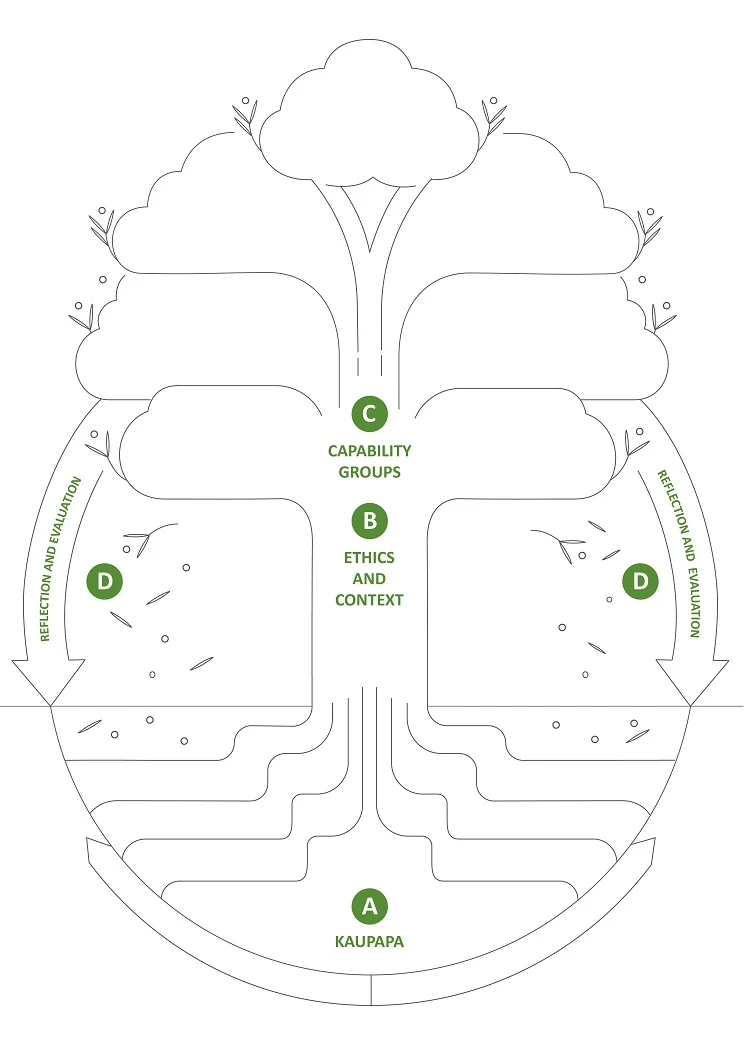
A. Ngā paiaka | The roots
Kaupapa as a strong foundation
Guiding us from the roots to the tips of the branches
He tina ki runga, he tāmore ki raro
In order to flourish above, one must have strong roots below
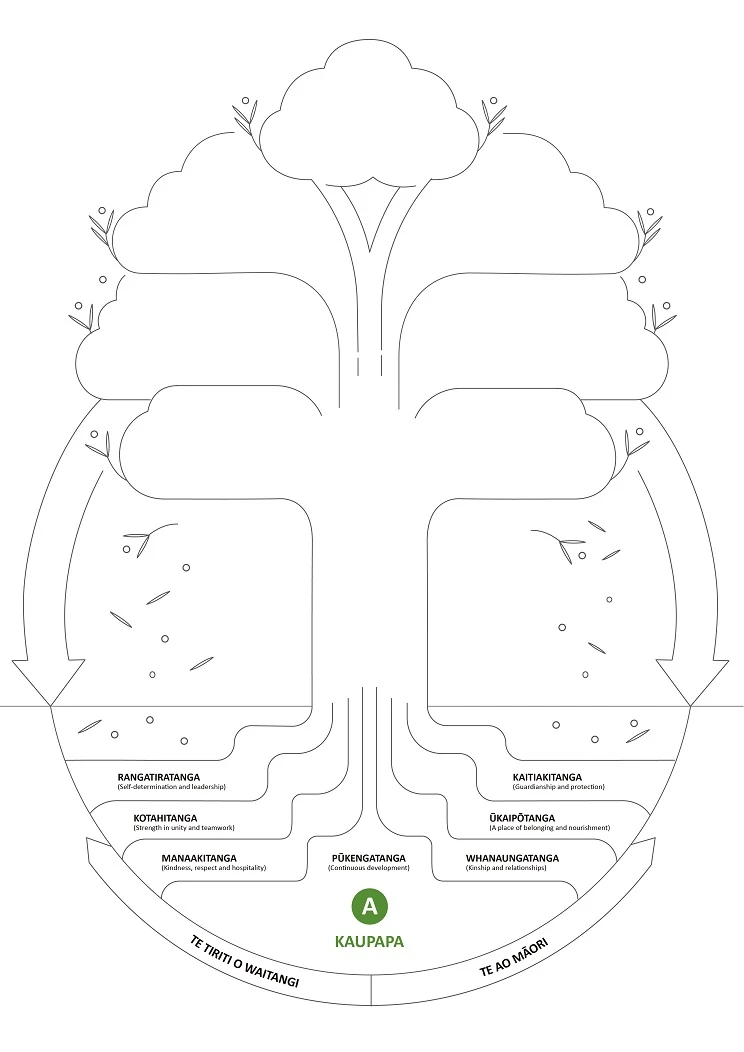
Te Tiriti o Waitangi
Ability to understand, respect and apply Te Tiriti o Waitangi principles and obligations in daily work practice.
Whakaaro | Your thoughts and reflections
After reading the descriptions in Te Tōtara, where do you think your capability level is currently at in this area? Rate how comfortable you are in this area out of the following capability levels:
Kōrero — Discussion (foundational)
Mōhio — Knowledge (comfortable)
Mārama — Understanding (confident)
Mātau — Wisdom (capable)
In this area, my greatest strength is (in a few words) [complete the sentence]
If anything, my ‘work in progress’ in this area (to develop more strength in) is to [complete the sentence]
How can I use this strength at mahi and with my kaimahi (staff/colleagues)?
What other reflections are noteworthy for me in this area?
Te ao Māori
Ability to understand and respect the Māori worldview as the interrelationship of the living, the environment and the spiritual realm with an overarching principle of balance. Ability to apply and respect te reo, tikanga, kawa and mātauranga Māori in daily work practice.
Whakaaro | Your thoughts and reflections
After reading the descriptions in Te Tōtara, where do you think your capability level is currently at in this area? Rate how comfortable you are in this area out of the following capability levels:
Kōrero — Discussion (foundational)
Mōhio — Knowledge (comfortable)
Mārama — Understanding (confident)
Mātau — Wisdom (capable)
In this area, my greatest strength is (in a few words) [complete the sentence]
If anything, my ‘work in progress’ in this area (to develop more strength in) is to [complete the sentence]
How can I use this strength at mahi and with my kaimahi (staff/colleagues)?
What other reflections are noteworthy for me in this area?
Kaupapa for this framework
These Māori values/concepts have been selected as guiding principles to support growth of the capability groups in the library and information sector.
Whakaaro | Your thoughts and reflections
After reading the descriptions in Te Tōtara, where do you think your capability level is currently at in this area? Rate how comfortable you are in this area out of the following capability levels:
Kōrero — Discussion (foundational)
Mōhio — Knowledge (comfortable)
Mārama — Understanding (confident)
Mātau — Wisdom (capable)
In this area, my greatest strength is (in a few words) [complete the sentence]
If anything, my ‘work in progress’ in this area (to develop more strength in) is to [complete the sentence]
How can I use this strength at mahi and with my kaimahi (staff/colleagues)?
What other reflections are noteworthy for me in this area?
B. Te tīwai | The trunk
Context for structure
Standing united as a sector will help us work together as a strong team
He tōtara wahi rua he kai na te ahi
A totara split in two is food for the fire
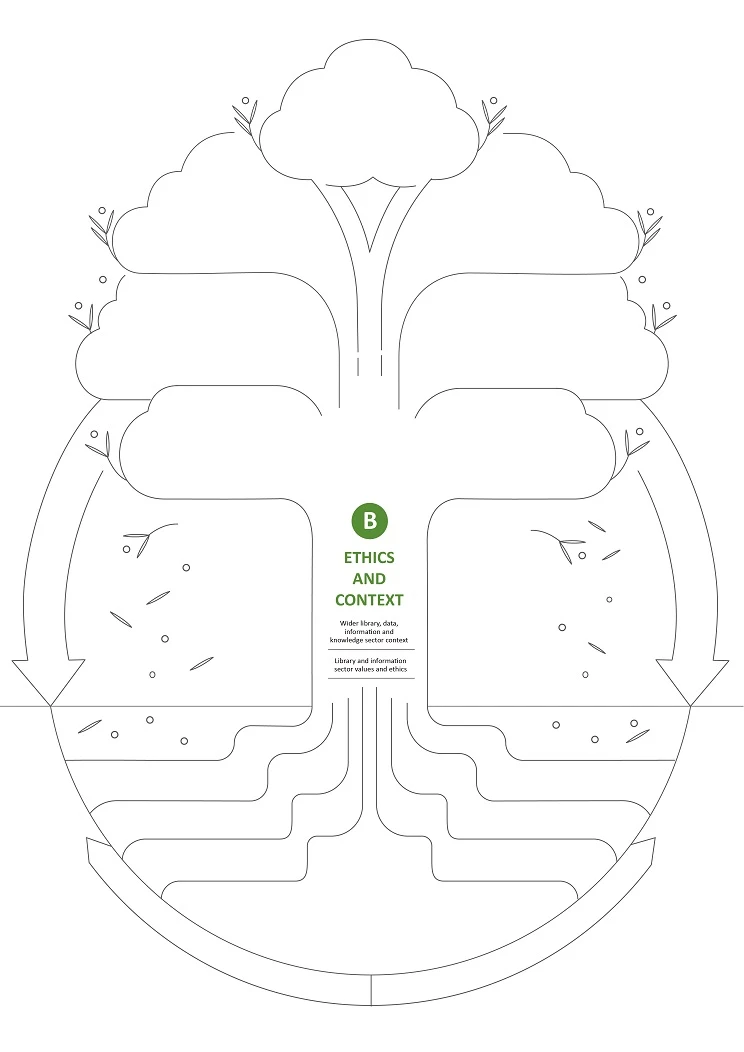
Librarianship and information sector values and ethics
Ability to understand, respect and apply librarianship and information sector values and ethics.
Whakaaro | Your thoughts and reflections
After reading the descriptions in Te Tōtara, where do you think your capability level is currently at in this area? Rate how comfortable you are in this area out of the following capability levels:
Kōrero — Discussion (foundational)
Mōhio — Knowledge (comfortable)
Mārama — Understanding (confident)
Mātau — Wisdom (capable)
In this area, my greatest strength is (in a few words) [complete the sentence]
If anything, my ‘work in progress’ in this area (to develop more strength in) is to [complete the sentence]
How can I use this strength at mahi and with my kaimahi (staff/colleagues)?
What other reflections are noteworthy for me in this area?
Wider library, data, information and knowledge sector context
Ability to understand and apply the wider library, data, information and knowledge sector context
Whakaaro | Your thoughts and reflections
After reading the descriptions in Te Tōtara, where do you think your capability level is currently at in this area? Rate how comfortable you are in this area out of the following capability levels:
Kōrero — Discussion (foundational)
Mōhio — Knowledge (comfortable)
Mārama — Understanding (confident)
Mātau — Wisdom (capable)
In this area, my greatest strength is (in a few words) [complete the sentence]
If anything, my ‘work in progress’ in this area (to develop more strength in) is to [complete the sentence]
How can I use this strength at mahi and with my kaimahi (staff/colleagues)?
What other reflections are noteworthy for me in this area?
C. Ngā rūhā | The branches
Seven capability groups to nurture
Guided by the kaupapa and context, each person’s capabilities grow at their own rate, and some capabilities can differ depending on functions, organisations and environment
Ahakoa he aha te rākau, he hua kei roto
No matter what the species of tree, they all bear fruit

Personal attributes
After reading the descriptions in Te Tōtara, where do you think your capability level is currently at in this area? Rate how comfortable you are in this area out of the following capability levels:
Kōrero — Discussion (foundational)
Mōhio — Knowledge (comfortable)
Mārama — Understanding (confident)
Mātau — Wisdom (capable)
Self-management and reflection
In this area, my greatest strength is (in a few words): [complete the sentence]
If anything, my ‘work in progress’ in this area (to develop more strength in) is to: [complete the sentence]
How can I use this strength at mahi and with my kaimahi?
What other reflections are noteworthy for me in this area?
Resilience and flexibility
In this area, my greatest strength is (in a few words): [complete the sentence]
If anything, my ‘work in progress’ in this area (to develop more strength in) is to: [complete the sentence]
How can I use this strength at mahi and with my kaimahi?
What other reflections are noteworthy for me in this area?
Life-long learning
In this area, my greatest strength is (in a few words): [complete the sentence]
If anything, my ‘work in progress’ in this area (to develop more strength in) is to: [complete the sentence]
How can I use this strength at mahi and with my kaimahi?
What other reflections are noteworthy for me in this area?
Teamwork and collaboration
After reading the descriptions in Te Tōtara, where do you think your capability level is currently at in this area? Rate how comfortable you are in this area out of the following capability levels:
Kōrero — Discussion (foundational)
Mōhio — Knowledge (comfortable)
Mārama — Understanding (confident)
Mātau — Wisdom (capable)
Hauora
In this area, my greatest strength is (in a few words): [complete the sentence]
If anything, my ‘work in progress’ in this area (to develop more strength in) is to: [complete the sentence]
How can I use this strength at mahi and with my kaimahi?
What other reflections are noteworthy for me in this area?
Communication
In this area, my greatest strength is (in a few words): [complete the sentence]
If anything, my ‘work in progress’ in this area (to develop more strength in) is to: [complete the sentence]
How can I use this strength at mahi and with my kaimahi?
What other reflections are noteworthy for me in this area?
Cooperation and information sharing
In this area, my greatest strength is (in a few words): [complete the sentence]
If anything, my ‘work in progress’ in this area (to develop more strength in) is to: [complete the sentence]
How can I use this strength at mahi and with my kaimahi?
What other reflections are noteworthy for me in this area?
Community care and services
After reading the descriptions in Te Tōtara, where do you think your capability level is currently at in this area? Rate how comfortable you are in this area out of the following capability levels:
Kōrero — Discussion (foundational)
Mōhio — Knowledge (comfortable)
Mārama — Understanding (confident)
Mātau — Wisdom (capable)
Diversity, inclusion and equity
In this area, my greatest strength is (in a few words): [complete the sentence]
If anything, my ‘work in progress’ in this area (to develop more strength in) is to: [complete the sentence]
How can I use this strength at mahi and with my kaimahi?
What other reflections are noteworthy for me in this area?
Accessibility
In this area, my greatest strength is (in a few words): [complete the sentence]
If anything, my ‘work in progress’ in this area (to develop more strength in) is to: [complete the sentence]
How can I use this strength at mahi and with my kaimahi?
What other reflections are noteworthy for me in this area?
Hospitality, service and relationships
In this area, my greatest strength is (in a few words): [complete the sentence]
If anything, my ‘work in progress’ in this area (to develop more strength in) is to: [complete the sentence]
How can I use this strength at mahi and with my kaimahi?
What other reflections are noteworthy for me in this area?
Sustainability
In this area, my greatest strength is (in a few words): [complete the sentence]
If anything, my ‘work in progress’ in this area (to develop more strength in) is to: [complete the sentence]
How can I use this strength at mahi and with my kaimahi?
What other reflections are noteworthy for me in this area?
Planning, management and leadership
After reading the descriptions in Te Tōtara, where do you think your capability level is currently at in this area? Rate how comfortable you are in this area out of the following capability levels:
Kōrero — Discussion (foundational)
Mōhio — Knowledge (comfortable)
Mārama — Understanding (confident)
Mātau — Wisdom (capable)
Leadership and management
In this area, my greatest strength is (in a few words): [complete the sentence]
If anything, my ‘work in progress’ in this area (to develop more strength in) is to: [complete the sentence]
How can I use this strength at mahi and with my kaimahi?
What other reflections are noteworthy for me in this area?
Evaluation and planning
In this area, my greatest strength is (in a few words): [complete the sentence]
If anything, my ‘work in progress’ in this area (to develop more strength in) is to: [complete the sentence]
How can I use this strength at mahi and with my kaimahi?
What other reflections are noteworthy for me in this area?
Advocacy
In this area, my greatest strength is (in a few words): [complete the sentence]
If anything, my ‘work in progress’ in this area (to develop more strength in) is to: [complete the sentence]
How can I use this strength at mahi and with my kaimahi?
What other reflections are noteworthy for me in this area?
Literacies, references and research services
After reading the descriptions in Te Tōtara, where do you think your capability level is currently at in this area? Rate how comfortable you are in this area out of the following capability levels:
Kōrero — Discussion (foundational)
Mōhio — Knowledge (comfortable)
Mārama — Understanding (confident)
Mātau — Wisdom (capable)
Digital literacy and dexterity
In this area, my greatest strength is (in a few words): [complete the sentence]
If anything, my ‘work in progress’ in this area (to develop more strength in) is to: [complete the sentence]
How can I use this strength at mahi and with my kaimahi?
What other reflections are noteworthy for me in this area?
Literacies and learning
In this area, my greatest strength is (in a few words): [complete the sentence]
If anything, my ‘work in progress’ in this area (to develop more strength in) is to: [complete the sentence]
How can I use this strength at mahi and with my kaimahi?
What other reflections are noteworthy for me in this area?
Information and reference services
In this area, my greatest strength is (in a few words): [complete the sentence]
If anything, my ‘work in progress’ in this area (to develop more strength in) is to: [complete the sentence]
How can I use this strength at mahi and with my kaimahi?
What other reflections are noteworthy for me in this area?
Research and evidence
In this area, my greatest strength is (in a few words): [complete the sentence]
If anything, my ‘work in progress’ in this area (to develop more strength in) is to: [complete the sentence]
How can I use this strength at mahi and with my kaimahi?
What other reflections are noteworthy for me in this area?
Information, knowledge and data management
After reading the descriptions in Te Tōtara, where do you think your capability level is currently at in this area? Rate how comfortable you are in this area out of the following capability levels:
Kōrero — Discussion (foundational)
Mōhio — Knowledge (comfortable)
Mārama — Understanding (confident)
Mātau — Wisdom (capable)
Information management
In this area, my greatest strength is (in a few words): [complete the sentence]
If anything, my ‘work in progress’ in this area (to develop more strength in) is to: [complete the sentence]
How can I use this strength at mahi and with my kaimahi?
What other reflections are noteworthy for me in this area?
Knowledge management
In this area, my greatest strength is (in a few words): [complete the sentence]
If anything, my ‘work in progress’ in this area (to develop more strength in) is to: [complete the sentence]
How can I use this strength at mahi and with my kaimahi?
What other reflections are noteworthy for me in this area?
Data collection, analysis and management
In this area, my greatest strength is (in a few words): [complete the sentence]
If anything, my ‘work in progress’ in this area (to develop more strength in) is to: [complete the sentence]
How can I use this strength at mahi and with my kaimahi?
What other reflections are noteworthy for me in this area?
Collection, records and archives management
After reading the descriptions in Te Tōtara, where do you think your capability level is currently at in this area? Rate how comfortable you are in this area out of the following capability levels:
Kōrero — Discussion (foundational)
Mōhio — Knowledge (comfortable)
Mārama — Understanding (confident)
Mātau — Wisdom (capable)
Collection management
In this area, my greatest strength is (in a few words): [complete the sentence]
If anything, my ‘work in progress’ in this area (to develop more strength in) is to: [complete the sentence]
How can I use this strength at mahi and with my kaimahi?
What other reflections are noteworthy for me in this area?
Records and archive management
In this area, my greatest strength is (in a few words): [complete the sentence]
If anything, my ‘work in progress’ in this area (to develop more strength in) is to: [complete the sentence]
How can I use this strength at mahi and with my kaimahi?
What other reflections are noteworthy for me in this area?
Digital content creation and curation
In this area, my greatest strength is (in a few words): [complete the sentence]
If anything, my ‘work in progress’ in this area (to develop more strength in) is to: [complete the sentence]
How can I use this strength at mahi and with my kaimahi?
What other reflections are noteworthy for me in this area?
Other specialist skills and capabilities
Write down any specialist or unique capabilities that are not covered in the framework that are important to your role or the organisation. For each capability, do the following:
Rate how comfortable you are in this area out of the following capability levels:
Mōhio — Knowledge (comfortable)
Mārama — Understanding (confident)
Mātau — Wisdom (capable)
Answer the following questions:
In this area, my greatest strength is (in a few words): [complete the sentence]
If anything, my ‘work in progress’ in this area (to develop more strength in) is to: [complete the sentence]
How can I use this strength at mahi and with my kaimahi?
What other reflections are noteworthy for me in this area?
D. Te rau hinga | The fallen leaves
Reflection and evaluation
Insights feed back into the roots and land, strengthening values and supporting nourishment and regeneration around us
Mai i te kōpae ki te urupa, tātou ako tonu ai
From the cradle to the grave, we are forever learning
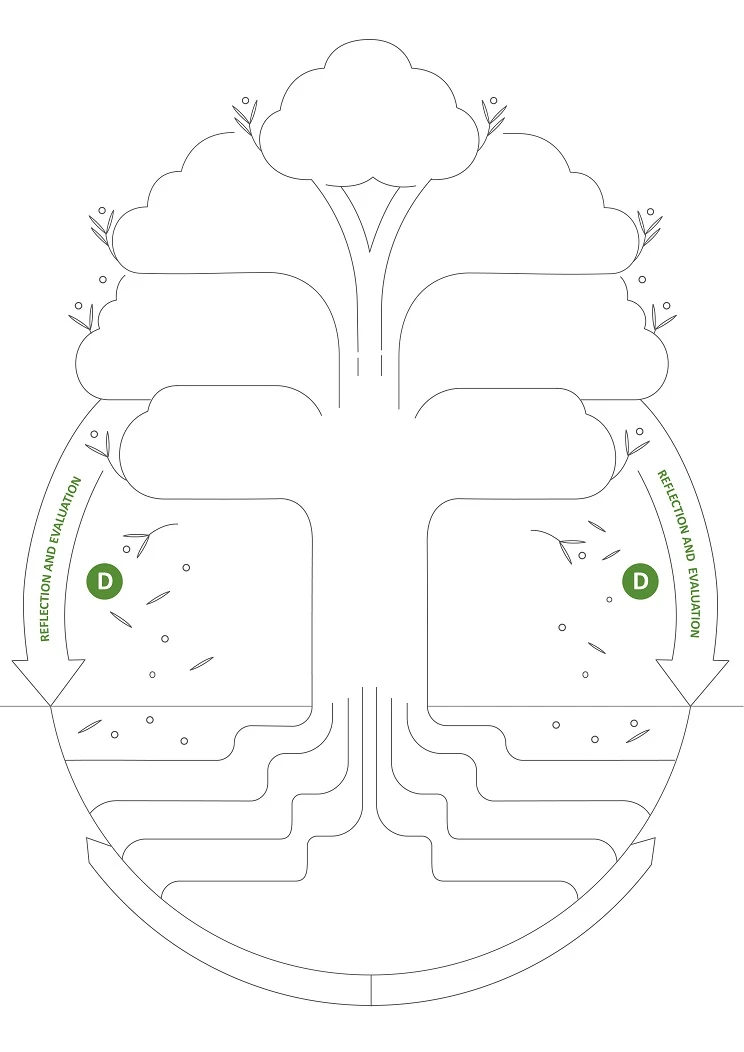
Reflection and evaluation
You have just reflected on each of the capabilities in Te Tōtara, well done! Now it is time to evaluate your whakaaro.
This section includes the final steps of Te Tōtara framework:
Do your SWOT analysis
To help evaluate your capabilities, you can first analyse your SWOT:
Strengths
Work in progress areas
Opportunities
Threats.
This SWOT analysis helps draw out your learning and development areas, find out development opportunities and how to overcome any learning blockages. If you know all these, you can proceed and add your goals into the summary plan.
Set your ATAMAI goals
After the SWOT analysis you’ll set some ATAMAI (smart) goals and flesh them out. If you know your goals, skip to the next step.
Summarise your plan on a page and create a calendar
You can summarise your ATAMAI goals on a 1-pager, and break down the steps on how to achieve your goals in the calendar. This becomes your learning and development framework for the year.
This is also available as an A3 if you want more space to write.
Kōrero with your team
Keep talking with your manager, team leader and colleagues about your learning and development. This might keep you accountable and help you stay on track, guides your journey, and supports the team around you in their development too!
Strengths and Work in progress tend to be about you as an individual although you could use this approach to reflect on a team or service.
Opportunities and Threats tend to be outside influences that you can anticipate impacting on you or your team.
Planning: SWOT
To plan what happens next in a way that has meaning and is useful, complete the SWOT analysis below:
Look back at your Strengths and Work in progress areas you completed for each capability in part A, B or C
Select a list of your top Strengths and Work in progress areas for the top row
Think of the opportunities for your further development and any threats to your learning in the bottom row
Think about how you use these opportunities or combat the threats using your strengths, knowledge, personal skills and experience.
Strengths
Based on your reflections, what are your 1–5 top strengths?
Work in progress
Which 1–3 areas/capabilities would like to develop in, to grow at work?
Opportunities
What learning and development opportunities in the three ‘work in progress’ areas above are you aware of (eg, within your organisation, through any networks or associations)?
Opportunities could also include other things like support, networking, technology, access to learning, positive trends or training events.
Threats
Think about your development areas, what are some of the threats that may pose a block to your learning?
This could include things like risks, changes in circumstances, obstacles or resources, skills or abilities needed. How can you use your Strengths to combat these threats?
Take action: set ATAMAI goals
Let’s use the outcomes from your SWOT analysis to set 1–3 goals that:
address your work in progress areas
use the opportunities you have available (or perhaps you need to research further opportunities)
address the threats that could potentially block your learning (using your strengths to combat these blockers).
Describe three ATAMAI (smart/clever) goals in a few words.
For each of them, answer some of the questions listed below. You don’t need to answer all the questions, they are just there to prompt your thinking.
If you know your goals already, you can skip this section and add them to your summary plan.
Aimed
What do I want to achieve?
When do I need to achieve this?
Why is the goal important?
Who is involved?
Time-Bound
How long should it take to accomplish this goal?
When will I check in on whether or not the goal has been completed?
Am I ready to start work on the goal?
Applicable
Is this goal related to my capability?
Is this goal related/relevant to my job description?
Is this goal related to my overall success (or the success of my organisation?)
Measurable
How will I measure my progress?
How will I know if my goal is achieved?
Who will help me be accountable?
Achievable
Is this goal achievable? (Don’t set too many goals at once.)
Will it be clear when the goal is complete?
Is it reasonable to complete the goal in the time allotted?
Intentional
What can I start doing today to work towards this goal?
What will I do each week to stay on track?
Summary plan: Taku Tōtara on a page
Write your three ATAMAI goals
Highlight the capabilities in Te Tōtara that you would like to grow in and are related to your ATAMAI goal
Put a star next to the capabilities that are your strengths
Complete the action plan calendar below
Kōrero with your team leader or team about your ATAMAI goal/s.
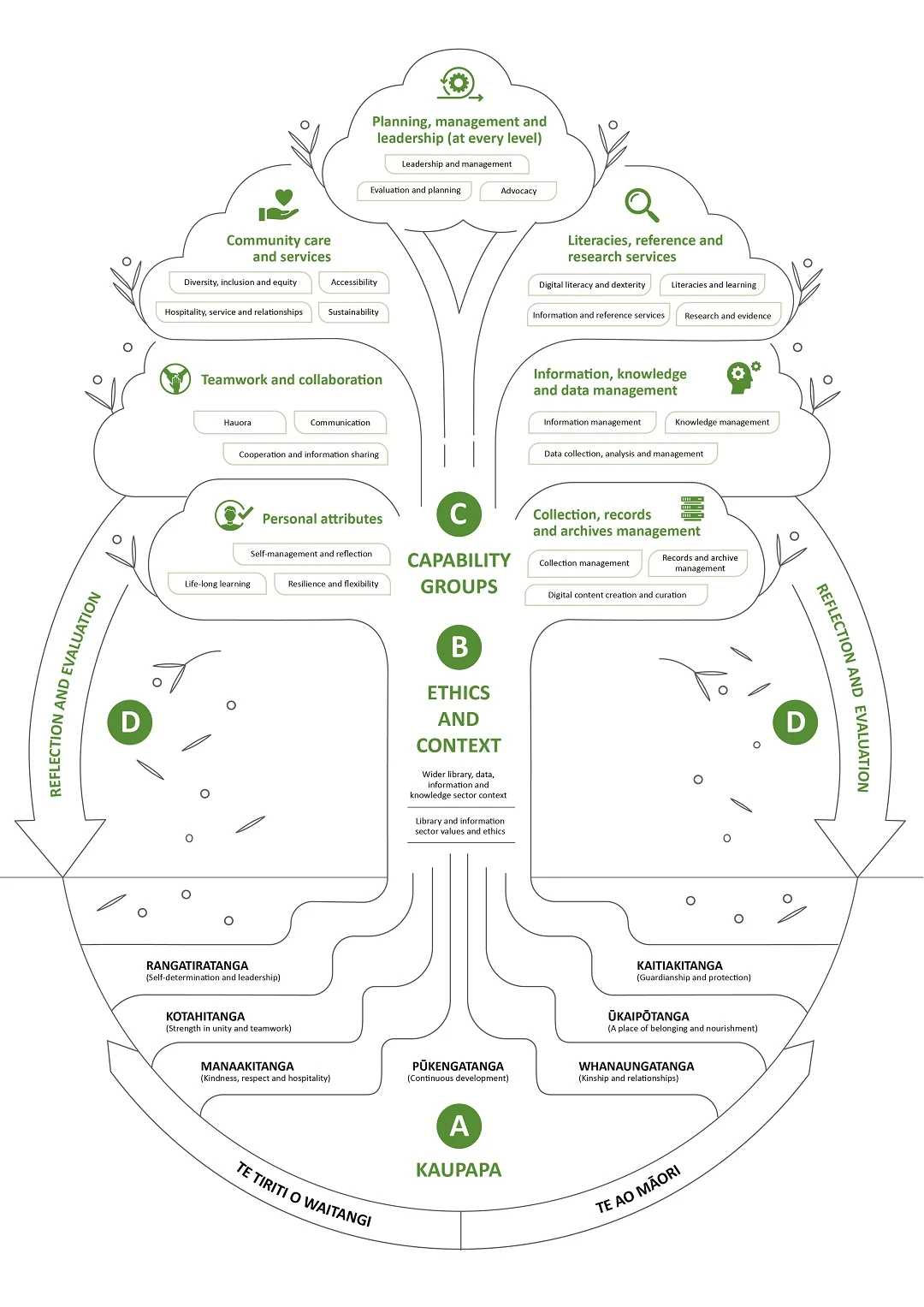
Long description — Te Tōtara capability framework infographic
Infographic representing the different elements of Te Tōtara as parts of a tree. The different elements are labeled as followed:
A. Kaupapa (represented as the roots of the tree)
Te Tiriti o Waitangi
Te Ao Māori
Rangatiratanga (Self-determination and leadership)
Kotahitanga (Strength in unity and teamwork)
Manaakitanga (Kindness, respect and hospitality)
Pūkengatanga (Continuous development)
Whanaungatanga (Kinship and relationships)
Ūkaipōtanga (A place of belonging and nourishment)
Kaitiakitanga (Guardianship and protection)
B. Ethics and context (represented as the trunk of the tree)
Wider library, data, information and knowledge sector context.
Library and information sector values and ethics.
C. Capability groups (represented as the branches of the tree)
Personal attributes
Self-management and reflection
Life-long learning
Resilience and flexibility
Teamwork and collaboration
Hauora
Communication
Cooperation and information sharing
Community care and services
Diversity, inclusion and equity
Accesibility
Hospitality, service and relationships
Sustainability
Literacies, reference and research services
Digital literacy and dexterity
Literacies and learning
Information and reference services
Research and evidence
Information, knowledge and data management
Information management
Knowledge management
Data collection, analysis and management
Collection, records and archives management
Collection management
Records and archive management
Digital content creation and curation
D. Reflection and evaluation (represented as leaves falling from the tree)
Action plan: Your learning and development calendar
Use the calendar below (starting after Matariki) to plan some high-level steps you'll take throughout the year towards achieving your ATAMAI goals.
For each of your three ATAMAI goals, answer the following:
Name of goal:
Outcome (short description of how you will measure, see, feel at the end of this year):
Plan out the steps that you'll take during each of the following seasons:
Takurua | Winter — Stocktake and plan ahead
Koanga | Spring — Nurture seeds and environment
Raumati | Summer — Help knowledge grow
Ngahuru | Autumn — Harvest and evaluate
Here's an example of some steps you might plan out for the first season:
Step 1: eg ask for support and approval
Step 2: eg check out available resources
Step 3: eg get clear on outcomes, create a lesson plan, sign up for course
Step 4: eg what else will support this learning
Step 5: eg block time in diary
Kōrero: guidance and accountability
Have a kōrero with your manager, team leader or colleagues about your learning and development. It is important to help you stay on track, have space to ask for help and share your learning with others.
At the start of your cycle, once you have completed Taku Tōtara, talk about:
How often will we catch up?
Will we follow a structure or just have a kōrero?
How will we address accountability?
How will this fit with other processes (personal development plans, performance reviews, etc)?
What else do we need/want to consider or include?
Remember, Te Tōtara and Taku Tōtara are adaptable so you can change things to make it work for you. Talk together at the start of the new financial year on how you will use this tool for the year ahead.
Tūngia te ururua kia tupu whakaritorito te tupu o te harakeke.
Clear away the overgrowing bush so that the new flax shoots will spring up.
The important thing to remember is that you take some regular time to reflect on your role, your organisation, your sector and community and how you fit in the wider scheme of things. Keep asking yourself:
What do I need to learn to be part of my changing team?
What can I do to share my knowledge with others?
How can we grow together to serve our community best as good Tiriti partners?
Ultimately, your insights will feed back into your Tōtara roots and the land around you, strengthening values and supporting nourishment and regeneration around us, our teams and communities.
And the lifecycle continues…
Whakatauki
Whaowhia te kete mātauranga
Fill the basket of knowledge